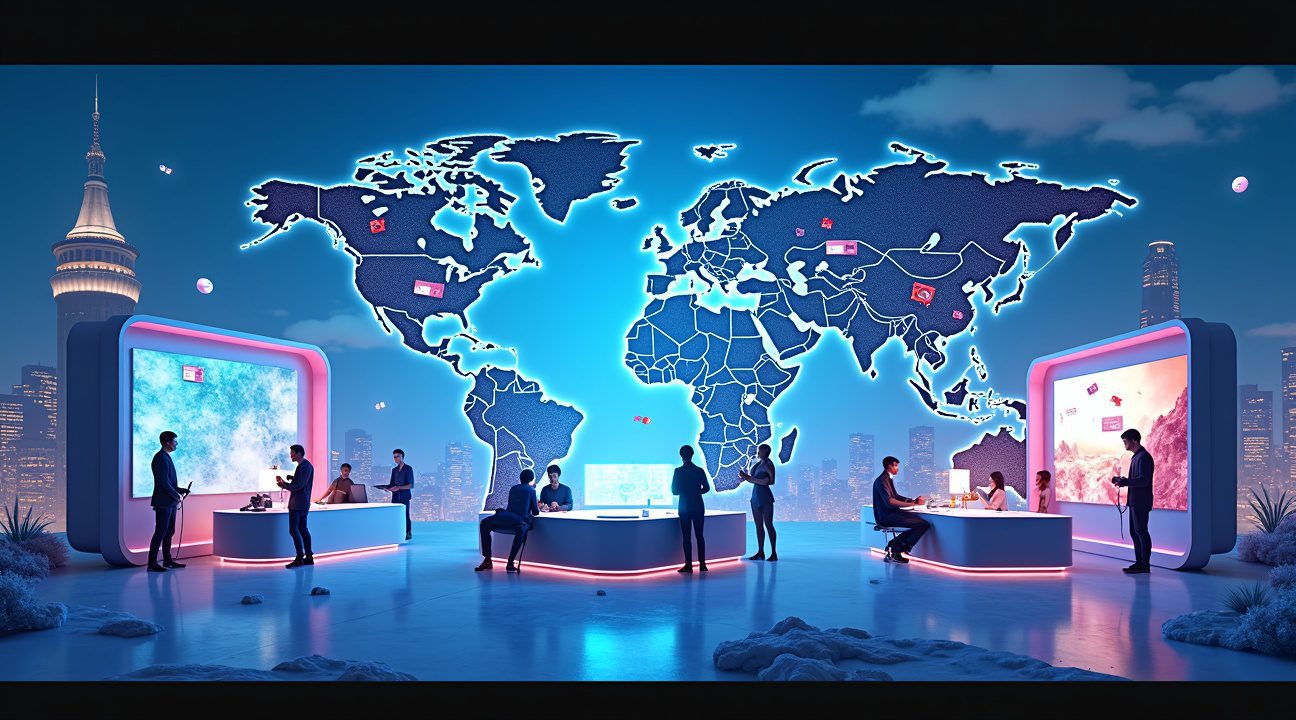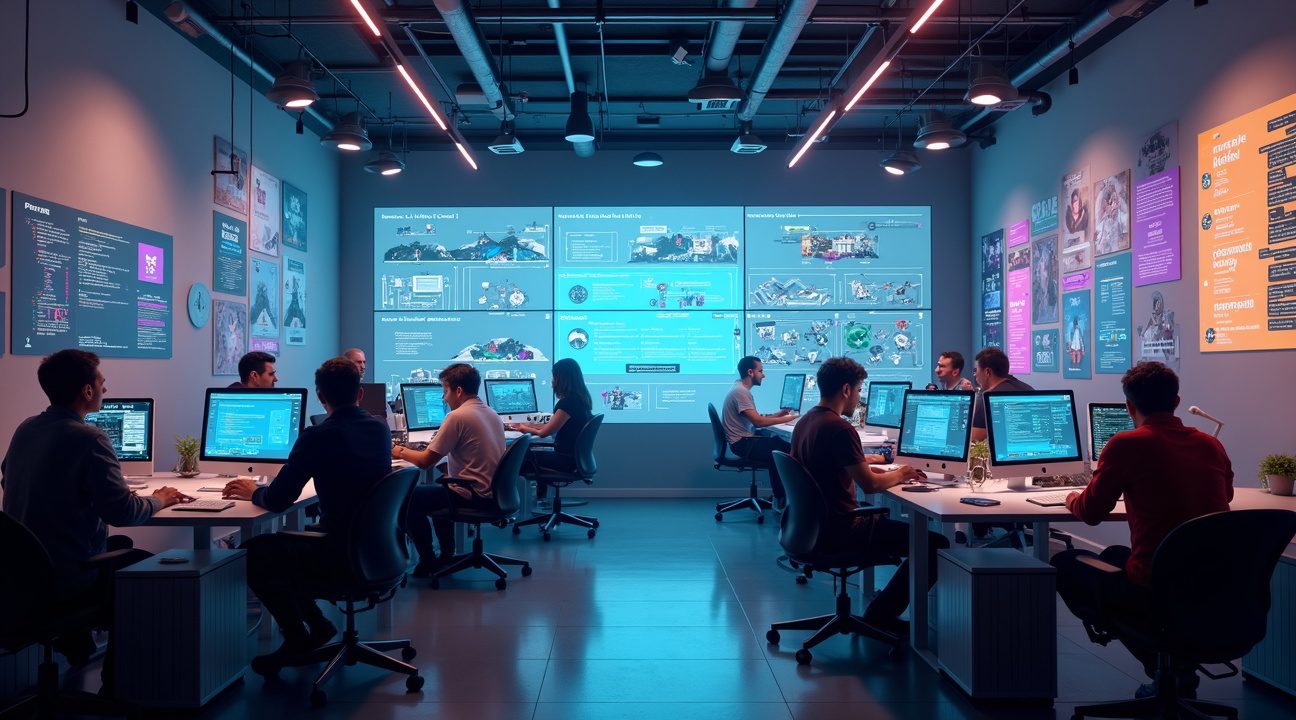Supercell, the Finnish gaming powerhouse behind Clash of Clans, has revealed a comprehensive three-pillar AI strategy that positions artificial intelligence at the core of their entire gaming operation while maintaining their signature player-focused culture.
The company has already integrated AI tools across every aspect of game development and operations, from code generation and creative asset production to real-time player personalization and support systems. This transformative strategy is designed to enhance both the workflow of developers and the experiences of players globally.
Key Takeaways
- Empowering development teams: Supercell’s AI framework aims to boost developers’ capabilities through advanced tools such as coding assistance and creative asset generation.
- Optimizing operations through personalization: AI is used to analyze player behavior, predict actions, and deliver real-time personalization enhancing in-game engagement and experience.
- AI Innovation Labs: The initiative includes creating three new AI Innovation Labs in Helsinki, San Francisco, and Tokyo by 2026. These labs will run structured eight-week programs fostering experimental AI-driven game development with up to 20 participants each cycle.
- Human-centric AI philosophy: Supercell adheres to a “human augmentation” mindset, using AI to complement and magnify the creativity of their teams rather than replacing human roles.
- Failing smart: True to their development ethos, the company supports rapid iteration and experimentation with AI, grounded in the principle that all uses of AI must elevate the overall player experience and game quality.
To delve deeper into Supercell’s initiatives, you can visit their official site through Supercell’s news page.
Supercell’s Three-Pillar Strategy to Transform Gaming with Artificial Intelligence
Supercell has unveiled an ambitious three-pillar strategy that positions artificial intelligence at the core of their gaming operations and future development. This comprehensive approach demonstrates how AI can revolutionize both internal processes and player experiences across mobile gaming platforms.
Empowering Development Teams Through Internal Enhancement
The first pillar, “give our people superpowers,” transforms how Supercell’s development teams create and maintain games. This initiative centers on code generation capabilities that streamline programming tasks, while CI/CD automation eliminates repetitive deployment processes. The company leverages AI to accelerate development workflows, allowing creative teams to focus on innovation rather than mundane technical tasks.
Optimizing Game Operations Through AI Personalization
The second pillar, “better operate our games,” addresses operational excellence through data-driven personalization. Supercell uses AI for mass personalization in user acquisition activities, identifying potential players who match successful player profiles. The system predicts player behavior patterns with remarkable accuracy, enabling the company to craft retention and monetization strategies that maximize lifetime value. This approach has already shown significant improvements in how games respond to player preferences and spending habits.
AI-Driven Gameplay Innovation to Expand the Game Portfolio
Supercell’s third pillar, “innovating our portfolio,” integrates AI features directly into gameplay mechanics. Players gain access to AI-powered creation tools that transform them from consumers into active creators within game environments. This shift represents a fundamental change in how mobile games operate, moving beyond traditional gameplay loops to embrace user-generated content and personalized experiences.
The implementation follows three distinct horizons that scale AI adoption across the organization:
- Horizon 1: Helps existing development cells operate smarter and faster through enhanced automation and analytics.
- Horizon 2: Focuses on proving AI features in new game releases, testing innovative mechanics before broader deployment.
- Horizon 3: Involves long-term initiatives such as AI-native games that redefine gameplay experiences.
These initiatives span multiple areas including:
- Mass personalization for user acquisition
- Content generation acceleration
- Player behavior prediction
- Live operations optimization
Looking Beyond Traditional Gaming: The AI-Native Future
Supercell’s long-term vision extends beyond current mobile gaming boundaries. They’re developing AI-native games that will create entirely new gameplay genres, similar to how Google Bards and other AI platforms have reshaped digital interactions. These experiences will blur the lines between gaming and entertainment, offering players unprecedented levels of customization and creative freedom.
The strategy acknowledges that AI integration requires careful balance between automation and human creativity. While AI handles data analysis and routine tasks, human developers retain control over creative direction and player experience design. This approach ensures that Supercell’s games maintain their distinctive character while benefiting from AI’s efficiency and personalization capabilities.
Finnish Developer Already Deploys AI Tools Across Every Game Operation
Supercell has transformed its entire development ecosystem by integrating artificial intelligence into every facet of game creation and operations. The Finnish gaming giant demonstrates how comprehensive AI adoption can revolutionize mobile gaming production at scale.
Development and Creative Production Enhanced by AI
The company leverages coding copilots to accelerate software development across its portfolio of games. These AI assistants help developers write more efficient code while reducing debugging time and improving overall productivity. Game balancing has also received an AI makeover through sophisticated bots that analyze player behavior patterns and automatically adjust difficulty curves and reward structures.
Creative asset generation represents another major breakthrough in Supercell’s AI implementation. The studio employs creative AI tools for both 2D and 3D asset creation, dramatically reducing the time required to produce visual elements for games like Clash of Clans. Video generation capabilities allow the team to create promotional content and in-game cinematics with unprecedented speed and efficiency.
Knowledge work automation has streamlined administrative tasks throughout the organization. ChatGPT integration supports various internal processes, while specialized prompting training programs ensure employees can maximize the potential of artificial intelligence tools effectively. MCP Server authentication systems provide secure access to these powerful capabilities across different departments.
Operations and Player Experience Revolution
Supercell’s operational AI deployment extends far beyond development. The company has successfully piloted creative brief generation systems that help marketing teams conceptualize campaigns more efficiently. AI-powered marketing analysis provides deeper insights into player preferences and market trends, while user acquisition asset creation tools generate targeted advertising materials automatically.
Live operations benefit significantly from AI integration, with machine learning platforms supporting reinforcement learning algorithms that optimize player engagement in real-time. These systems continuously analyze player behavior and adjust game events, offers, and content delivery accordingly.
Player support represents perhaps the most visible AI implementation for users. The company’s AI-driven support systems deliver personalized service 24/7 globally, handling player inquiries and issues with increasing sophistication. This approach ensures consistent service quality regardless of time zones or language barriers.
Real-time personalization capabilities allow each player to experience customized content based on their playing patterns and preferences. Creative workflow optimization has streamlined the production pipeline, enabling teams to iterate faster and respond more quickly to player feedback. Live operations automation handles routine tasks that previously required manual intervention, freeing human operators to focus on strategic decisions.
The comprehensive nature of Supercell’s AI adoption reflects a strategic vision that recognizes AI’s transformative potential across all aspects of game development and operations. From initial concept to player retention, artificial intelligence now plays a crucial role in maintaining the company’s competitive edge in the mobile gaming market.
Monetization pilots incorporate AI algorithms to optimize in-game purchase opportunities and pricing strategies. These systems analyze player spending patterns and present offers at optimal moments, maximizing revenue while maintaining positive player experiences. The integration of AI into every operational layer demonstrates Supercell’s commitment to staying at the forefront of technological innovation in gaming.
This comprehensive AI deployment strategy positions Supercell as a leader in the industry’s digital transformation, showing how established gaming companies can successfully integrate cutting-edge technology without compromising their core creative vision or player satisfaction.

Global AI Innovation Lab Network Expands to Three Continents by 2026
Supercell’s commitment to artificial intelligence innovation takes shape through strategically positioned AI Innovation Labs that span three continents. These specialized incubators function as experimental spaces where developers can explore how AI technology intersects with game development, all while staying true to Supercell’s core mission of creating memorable gaming experiences for players worldwide.
Current Lab Locations and Structure
The company currently operates two fully functional AI Innovation Labs in Helsinki and San Francisco, with each facility designed to foster creative experimentation in gaming AI applications. Both locations follow an identical eight-week program structure that accommodates up to 20 participants, organized into small teams of one to three members. This intimate setting allows for focused collaboration and ensures each participant receives adequate attention and resources throughout the program duration.
The San Francisco lab completed its most recent cycle from September 22 to December 2, 2025, providing participants with comprehensive support including:
- Expert mentoring
- Dedicated office space
- Accommodations
- Access to cutting-edge development resources
This holistic approach removes common barriers that might prevent talented developers from fully engaging with AI experimentation in gaming contexts.
Tokyo Expansion and Application Process
March 2026 marks a significant milestone as Supercell launches its third AI Innovation Lab in Tokyo, extending the company’s reach into the Asian market. The Tokyo facility represents more than geographical expansion; it acknowledges the region’s unique gaming culture and development expertise, particularly in mobile gaming sectors where Supercell continues to innovate.
Applications for the Tokyo lab open in early 2025, giving interested developers several months to prepare their submissions. The selection process operates on merit-based applications, where teams must demonstrate:
- Technical capability
- Alignment with Supercell’s vision for AI-enhanced gaming experiences
Successful applicants gain access to the same comprehensive support structure that characterizes the Helsinki and San Francisco programs.
The hands-on mentoring component distinguishes these labs from typical accelerator programs. Gaming industry experts work directly with participants, sharing practical insights about implementing AI solutions that enhance player engagement rather than simply showcasing technological capabilities. This approach ensures that AI integration serves gameplay purposes rather than existing as a novelty feature.
Each lab maintains a balance between structured learning and creative freedom, allowing teams to pursue projects that might seem unconventional but could lead to breakthrough applications. The eight-week timeframe provides sufficient duration for meaningful prototype development while maintaining the intensity necessary for focused innovation.
The global network strategy positions Supercell to tap into diverse talent pools and cultural perspectives on gaming. Helsinki brings Nordic design sensibilities and technical expertise, San Francisco contributes Silicon Valley’s AI advancement culture, and Tokyo adds deep mobile gaming knowledge and Asian market insights. This geographical diversity enriches the overall program by exposing participants to varied approaches to game development and AI implementation.
The expansion reflects broader industry trends where AI competition intensifies among technology companies, with gaming serving as a particularly fertile ground for AI applications. Supercell’s lab network positions the company to stay ahead of these developments while maintaining its reputation for player-focused game design.
The program’s emphasis on small team sizes ensures that individual contributors don’t get lost in larger group dynamics, a common problem in traditional incubator programs. Teams of one to three members can move quickly, iterate rapidly, and maintain clear communication throughout the development process. This structure particularly suits AI experimentation, where rapid prototyping and testing often determine project success.
By 2026, this three-continent network will create a continuous cycle of innovation, with programs running at different times throughout the year. This staggered schedule allows Supercell to maintain consistent engagement with the global AI development community while spreading resource allocation across multiple timeframes and regions.

The “Supercell Way” Ensures AI Amplifies Creativity Without Replacing People
Supercell’s approach to AI integration centers on three fundamental principles that define how the gaming giant views artificial intelligence’s role in its operations. The company believes AI should enhance game quality for players first and foremost, accelerate creativity rather than stifle it, and augment employees instead of making them obsolete.
This philosophy reflects a careful balance between technological advancement and human-centered design. Artificial intelligence continues evolving across industries, yet Supercell maintains that technology serves people, not the other way around. The company’s leadership recognizes that players experience games through emotional connections and creative storytelling that AI alone can’t replicate.
Smart Failure Strategy Drives Innovation
Supercell’s “failing smart” mindset extends to its AI initiatives, giving the company flexibility to terminate underperforming projects without hesitation. This approach encourages experimentation while preventing resource waste on initiatives that don’t deliver player value. Teams can explore AI applications knowing that learning from unsuccessful attempts contributes to future breakthroughs.
The company’s willingness to shut down AI projects that don’t meet standards demonstrates commitment to quality over quantity. This strategy aligns with Supercell’s historically selective approach to game development, where they’ve cancelled numerous projects to focus resources on titles with genuine potential for player engagement.
Preserving Team Autonomy Through AI Enhancement
The cell model that made Supercell famous operates on small, autonomous teams with creative control over their projects. AI deployment aims to increase productivity within these teams without expanding their size unnecessarily. Rather than replacing team members, AI tools help existing developers accomplish more ambitious creative goals.
Teams gain access to AI capabilities that handle repetitive tasks, allowing human creativity to focus on game design elements that require intuition and emotional intelligence. Competition among AI platforms provides Supercell with multiple options for finding tools that fit their specific workflow requirements.
This human augmentation approach addresses concerns that AI might replace human workers by explicitly positioning technology as a creative amplifier. Developers can prototype faster, iterate on concepts more efficiently, and test player experiences with greater precision while maintaining the human insight that drives compelling gameplay.
Player-centric experiences remain the ultimate measure of AI success within Supercell’s framework. Every AI implementation must demonstrably improve what players encounter in their games, whether through better matchmaking algorithms, more responsive game mechanics, or enhanced visual effects that wouldn’t be feasible without AI assistance.
Major technology companies like Apple are developing AI competitors to existing platforms, giving game developers more choices for integrating these capabilities. Supercell’s approach ensures they can adapt to new AI tools while maintaining their core philosophy of human-centered development.
The company’s commitment to preserving small team structures through AI enhancement reflects confidence that technology can multiply human creativity without requiring organizational restructuring. Teams maintain decision-making authority over their projects while gaining powerful tools that expand their capabilities.
This balanced approach positions Supercell to benefit from AI advancement while protecting the creative culture that produced globally successful titles. By viewing AI as an amplifier rather than a replacement, the company maintains its competitive edge through enhanced human creativity rather than automated game development.

How AI Strategy Maintains Company Culture While Embracing Technological Revolution
Supercell has established three core implementation principles that keep their AI adoption perfectly balanced with their organizational DNA and cultural foundation. These guiding principles shape every AI-related decision while preserving what makes the company unique and supporting breakthrough innovation.
Creative Amplification Through Smart Automation
AI transforms how Supercell’s teams approach creative work by accelerating the iteration process for both artwork and game concepts. Artists can now explore dozens of visual styles in minutes rather than days, while game designers rapidly prototype mechanics that would previously require weeks of manual development. This technological boost doesn’t replace human creativity but multiplies its impact across every project phase.
The company embeds two critical philosophies into their project workflows:
- Creative amplification – AI handles time-intensive tasks so designers focus on high-level creative decisions
- ‘Failing smart’ approach – Teams experiment with AI-generated concepts rapidly, learning from quick iterations
- Autonomous innovation support – Each cell maintains freedom to adopt AI tools that fit their specific creative process
- Human-centered automation – Repetitive tasks get automated while strategic thinking remains human-driven
Supercell’s famous ‘cell’ structure receives particular attention in their AI strategy. Each autonomous team gets the freedom to integrate artificial intelligence tools that match their unique workflow and creative goals. This decentralized approach prevents a one-size-fits-all mentality while ensuring each cell can innovate at their own pace.
Job displacement concerns get addressed head-on through Supercell’s human augmentation philosophy. Leadership frames AI as an empowerment tool rather than a replacement system. Employees receive training on how AI can enhance their existing skills while taking over mundane tasks that previously consumed valuable creative time. This approach builds confidence rather than fear around technological advancement.
The company recognizes that maintaining their culture during technological shifts requires intentional effort. They’ve seen how other gaming companies struggled when AI implementation wasn’t properly aligned with existing values. Supercell’s strategy prevents this disconnect by ensuring every AI tool and process reinforces their core principles of player-first thinking and team autonomy.
Creative teams now spend more time on conceptual work and player experience design since AI handles technical execution of repetitive elements. Character artists explore multiple visual directions simultaneously while environment designers test various atmospheric concepts without the previous time constraints. This acceleration enables deeper creative exploration within typical project timelines.
The ‘failing smart’ methodology becomes particularly powerful when combined with AI capabilities. Teams can test game mechanics, visual styles, and player interactions much faster than traditional methods allowed. Quick failures lead to rapid learning cycles, ultimately producing better final products. Advanced AI tools make these rapid prototypes possible without overwhelming development resources.
Supercell’s approach acknowledges that successful AI integration requires more than just purchasing new software. Cultural alignment ensures that technological advancement supports rather than undermines the company’s collaborative environment. Each cell maintains ownership over their AI adoption timeline while sharing successful strategies across the organization.
The human augmentation philosophy extends beyond individual roles into team dynamics. Project managers use AI for scheduling and resource optimization while creative directors leverage machine learning for player behavior analysis. This distribution of AI capabilities across various functions creates a comprehensive support system rather than concentrated technological dependence.
Leadership emphasizes that AI success depends on maintaining Supercell’s player-centric culture. Every AI implementation gets evaluated based on its potential impact on game quality and player satisfaction. Technology serves the creative vision rather than driving it, ensuring that emerging AI capabilities enhance rather than replace human judgment in critical decisions.
This balanced approach positions Supercell to benefit from AI advancement while preserving the cultural elements that created their success. The three implementation principles create a framework that can adapt to future technological developments without sacrificing the company’s core identity or creative excellence.

Sources:
Supercell – “Supercell’s Three-Pillar Strategy to Transform Gaming with Artificial Intelligence”
Supercell – “How AI Strategy Maintains Company Culture While Embracing Technological Revolution”


